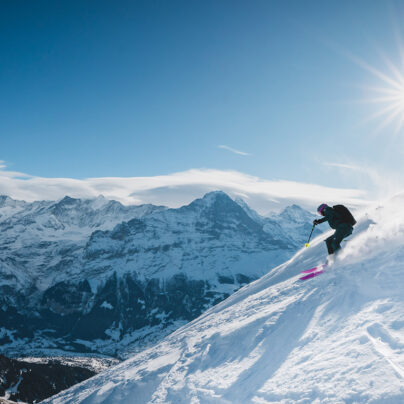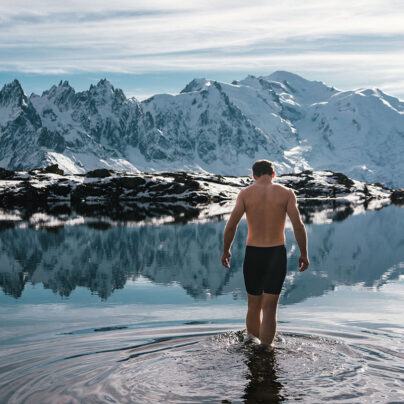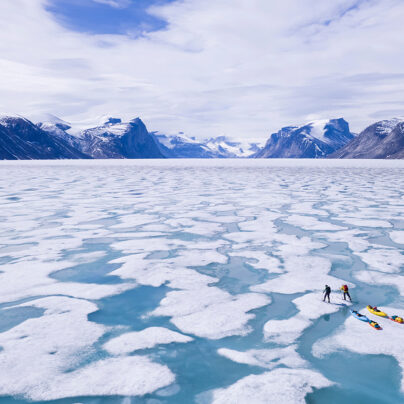The Wild North-West
Kayaking and Running Cape Wrath
Will Herman
Tortured by clegs that swarmed in the fierce heat, settling and sticking to sweat-soaked skin, bites boring into neck and calves, my shoulders burned. Swollen feet ached, and my lips cracked as I pushed the pace a little, sensing an end to the climb. Just ahead, the narrow road turned and passed through a wide col – the highest point I’d reach today.
17 miles in, another 9 to go. I’d been preparing myself for this moment. Paddling beneath the vast cliffs of Scotland’s north coast, approaching Durness, I knew my day was only just beginning. But despite the heat and burning sun, I was looking forward to the run – looking forward to closing the loop on our journey around this wild north-west corner of Scotland. It’s easy to forget the thirst and heat from the seat of a kayak.
I’d passed a natural spring a few miles back – ice-cold water from deep underground in which I’d wallowed, slaking my thirst. It seemed a long time ago. The endless miles of shimmering air above hot tarmac stretched ahead, and my mind’s eye slipped to the drama of Sutherland’s wild coastline, foam-flecked seas and the cliffs towering above heaving swells and frantic clapotis – waves colliding in jagged peaks, the clamour of guillemots and gannets that filled the skies and the mounting tension as we had approached Cape Wrath two days earlier.
The morning’s heat had given way to thick fog rolling in from the Atlantic on leaving Scourie. Surfing against the tide on waves that pushed us through the Sound of Handa beneath darkening skies, I slowed to cut in behind a yacht crossing the channel. The crew waved, perhaps surprised by our speed, and I stalled the boat. We spoke of the weather and the heat, the fog and rapidly changing seas, of Sandwood Bay and the surf – and what lay beyond.
The endless miles of shimmering air above hot tarmac stretched ahead, and my mind’s eye slipped to the drama of Sutherland’s wild coastline, foam-flecked seas and the cliffs towering above heaving swells.


I was tiring, dehydrated, thinking of the surf that morning on leaving Kervaig Bay. Clean lines of cold water, breaking in brilliant white in their rush to the beach.
‘Are you going around the top?’ It was clear we were on a journey, Cape Wrath the obvious destination. ‘That’s the plan.’ Optimism tempered with caution, nerves and common sense.
The yacht was forced to take a deeper passage while we took a direct line among the skerries. Our paths crossed again moments later; they bound for the shelter of Loch Laxford, ourselves for something altogether different.
A needling, swelling pain burned in my neck. Suddenly aware of the steepening road ahead, I was back with the clegs, the heat and hills rising all around. Blue scattered lochs glittered beyond the heather, distant summits high above capped in quartz – it could almost have been snow that covered their arid ridges. A breeze at the col had given temporary relief, but now, running in to a narrow corridor between cliffs and dense birch, the air was thick and the flies incessant in their attack. I was tiring, dehydrated, thinking of the surf that morning on leaving Kervaig Bay. Clean lines of cold water, breaking in brilliant white in their rush to the beach. We sat and watched, the boats held in the sand, waiting for the set to pass through, timing our break for open water with the smaller waves that followed.
Our second day of paddling began at Sheigra – a small bay and sheltered beach offering an alternative to the surf landing at Sandwood. We paddled quickly out beyond the protection of the islands, beneath striking cliffs of Lewisian gneiss, the scene of many happy days’ climbing in years past. Pushing north, now acutely aware of the exposure, we committed to the paddling ahead. We had crossed our Rubicon in passing Am Buachaille – the stack that stands proud of the cliffs to the south of Sandwood Bay – on smooth rolling seas, the din of surf on the beach tracking our progress north until rising cliffs blocked all thoughts except Cape Wrath.
It was close now, the seas growing rapidly as waves collided with sandstone walls and bounced back towards open water. Breaking crests of brilliant white all around, the boats rising and plunging amid the chaos. This was it. The headland that calls its siren song to every sea kayaker. Without warning, the cliffs ended, the swell eased, the seas suddenly less frantic. A huge arch loomed into view. Above, the striking red foghorn of the lighthouse clear beneath blue skies. We had turned the cape and paddled in towards the cliffs, talking animatedly now, gripping the paddles a little less tightly, relaxing as we moved east beneath cliffs gargantuan in scale, puffins, kittiwakes, skuas, gannets and guillemots circling in every direction. Landing that afternoon, surfing onto Kervaig’s perfect sands, elated to have rounded Cape Wrath, survived the clapotis and the powerful tidal flows beneath this infamous headland, I stood in awe on this wild beach, soaking in every moment, absorbing every detail and committing the scene to memory.


I was dropping steeply, too fast, tired legs struggling to resist the momentum, thighs burning. A cloud of dust followed me as I ran the dry track, away for a few precious seconds from the road. I was fixed now on closing the loop, the last miles unseen – but the sea was close once more. I could smell the coast, taste the salt that hung in the hot afternoon air. It had been the same among the stacks and skerries that litter the coast east of Kervaig Bay. Washed by the swells, foam rushing across and through narrow channels between rocks, we passed some with care beyond the reach of breaking waves; others we passed amongst, riding the swell, surfing beneath giant cliffs before moving offshore once more.
Slowly the cliffs dropped in height. Balnakeil Bay opened before us, the sea now like a mirror. I stripped the salt-caked cag from my arms and paddled on into the Kyle of Durness, moving with the flood tide towards Keodale. We landed once on white sands, drinking in the last of this journey, before launching again on gin-clear water to paddle the last kilometres. Soon we landed on a slip where those waiting for the ferry looked on expectantly, anticipating the rough journey across the Parph to Cape Wrath that would follow.
Their journey to and from the lighthouse would be done before my return. It was time to run. To close the loop on our journey around Cape Wrath and fulfil an ambition held since my first visit to this wild northern coast where the ocean reaches unbroken between continents.
Will’s interest in sea kayaking was first as a means to reach remote sea cliffs to attempt new routes but as the possibilities of longer journeys on the sea became apparent, so the climbing began to take a back seat. Still passionate about the mountains, Will’s spiritual home remains the Scottish Highlands and Islands and when he is not kayaking, can often be found fell running or carrying his bike to the summit of one mountain or another seeking out a promising descent.
A freelance photographer and writer, Will is sponsored by Rockpool Kayaks.
rockpoolkayaks.com
Website: Hills, Waves & Wheels
runswithaxes.blogspot.co.uk






